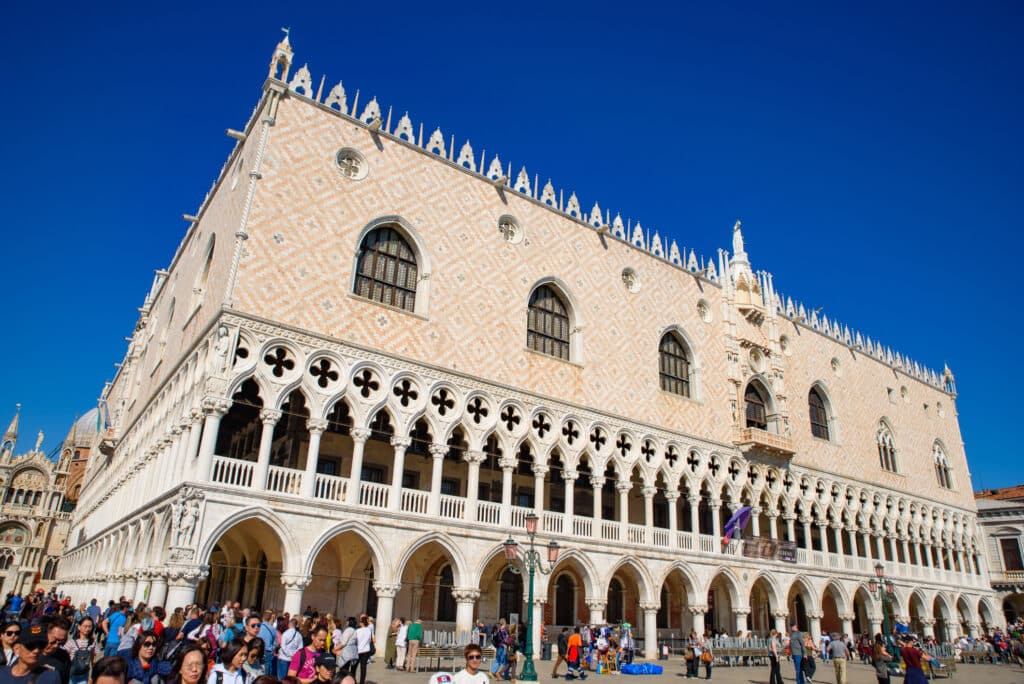
The Doge’s Palace entrance fee for 2024 is €25 if booked online at least 30 days in advance, or €30 for a standard last-minute ticket. This standard ticket covers not only the palace itself but also the Museo Correr, the National Archaeological Museum, and the Marciana Library in St. Mark’s Square. Reduced tickets for youth (ages 6–14), students (15–25), and seniors over 65 are €15 (or €13 with early booking), while children under 6 enjoy free entry.
The palace’s opening hours vary by season: from April through October it’s open 9:00–19:00 (last admission at 18:00), and from November through March 9:00–18:00 (last admission at 17:00).During peak summer months, it even stays open late until 23:00 on Fridays and Saturdays (from May through September 2025). Our team visited on 3 July 2025, and all information is valid as of that date.
Exploring the Doge’s Palace: History and Highlights
Ever wondered what awaits inside the Doge’s Palace? Stepping through the Porta della Carta gateway, we found ourselves immersed in the heart of Venetian history and grandeur. This Gothic-Renaissance palace was the seat of the Venetian Republic’s government for centuries, combining sumptuous state rooms and court chambers with dark prisons hidden behind its elegant façade. For a sense of its cultural significance, the entire city of Venice – including the Doge’s Palace – was declared a UNESCO World Heritage Site in 1987.
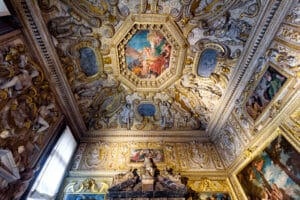
Interior of Doge`s Palace

Interior of Doge`s Palace
Its no surprise that over a million visitors flock to this palace each year to witness its splendor firsthand. Inside, nearly every corner is adorned with art: golden ceilings, intricate carvings, and masterpieces by Renaissance painters like Tintoretto and Veronese surround you at each step. We were particularly impressed by the Scala d’Oro, the “Golden Staircase” that once welcomed visiting dignitaries with its lavish gilded stucco and grand frescoes. Climbing that ornate stairway, reserved in the past for only the most esteemed guests, felt like walking into a living postcard of Venice’s opulence.
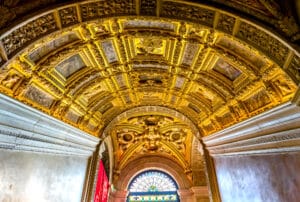
Scala d’Oro
What about the halls where Venice’s fate was decided? The palace’s epicenter is the Great Council Chamber, one of the largest rooms in Europe, where the Republic’s Great Council convened. Here you can gaze up at Il Paradiso by Jacopo Tintoretto – a colossal oil painting said to be one of the largest ever created on canvas, depicting over 500 heavenly figures.

Il Paradiso by Jacopo Tintoretto. Photographer: © Vladislav Gajic | Dreamstime
Standing under this artwork was humbling; we spent long minutes tracing the hundreds of characters in the scene, a testament to Venice’s artistic glory. In adjoining chambers like the Chamber of the Council of Ten, you’ll sense the intrigue of the powerful committee that once met in secrecy. Their meeting room is filled with dark wood paneling and symbolic paintings, hinting at the palace’s role in both governance and mystery. Throughout the tour, we marveled at how each salon and gallery had its own story – from the Doge’s modest private apartments (surprisingly small to keep the ruler humble) to the armory exhibiting steel armor and weapons from Venetian conquests. We definately recommend dedicating at least 2 hours for your visit to absorb all these details. During our visit, we spent about two hours exploring and honestly could have lingered longer admiring the art and architecture.
Yet, the Doge’s Palace isn’t all about gilded glamour – it also harbors a somber side. As you wander into the narrow prison cells of the palace, the atmosphere changes dramatically. Why is the famous limestone bridge connecting the palace to the prison called the Bridge of Sighs? According to legend, convicted prisoners would let out a final sigh as they glimpsed their last view of beautiful Venice through the small window grills while crossing into the prison.
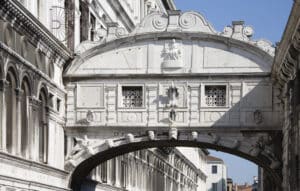
Bridge of Sighs
Walking through this dim passage ourselves, we felt a chill – it was easy to imagine those despairing sighs echoing in the silence. The damp cells (known as Piombi, the “Leads” for their lead-topped roof) once held inmates like the legendary Giacomo Casanova, who famously escaped from this very prison in 1756 with a daring plan.
We were fascinated to see Casanova’s cell and the adjoining interrogation chambers, which together paint a vivid picture of Venice’s justice system. Note that while the regular visit route through the Doge’s Palace (including the grand rooms and main courtyard) is fully accessible by elevator, the old prisons and secret passages are not wheelchair accessible due to their historic architecture. If you’re up for a deeper dive, consider the optional Secret Itineraries Tour – we joined this guided tour on a previous trip and found it eye-opening. It led us into hidden offices, the attic prison, and even the torture chamber (a grim small room with a trapdoor) that are not included on the standard admission ticket. The extra cost was worth the unique perspective, though be aware these secret areas also involve tight staircases and are not recommended for those with limited mobility.
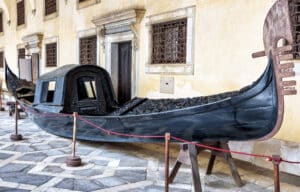
Vintage gondola at Doge`s Palace
Beyond the Palace: Nearby Sights and Dining Options
After touring the Doge’s Palace, we suggest you take time to enjoy its iconic surroundings. Stepping right outside, you’re in the midst of St. Mark’s Square (Piazza San Marco) – a destination in its own right. Adjacent to the palace is the magnificent St. Mark’s Basilica, with its awe-inspiring gilded domes and mosaics. We highly recommend visiting the Basilica while you’re here (note that entry there is separate and has its own hours and dress code). In fact, many visitors pair the palace and the basilica in one trip, since they sit shoulder to shoulder, symbolizing the blend of Venice’s secular and religious history.
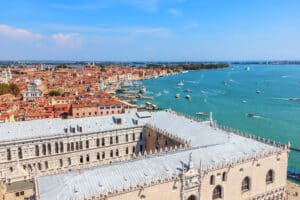
Doge`s Palace and the coast of Venice
If you have extra time on your ticket, the included Museo Correr on the opposite side of St. Mark’s Square offers fascinating exhibits on Venetian art and history – it was much quieter when we stopped by, making for a nice change of pace after the busy palace. Another short stroll away is the Campanile di San Marco (St. Mark’s Bell Tower), which we climbed on a clear afternoon for a breathtaking 360° view over Venice’s rooftops and the lagoon. The panorama from the top, with the Doge’s Palace and Basilica down below, is something we’ll never forget. Additionally, for a pleasant break, we wandered along the Riva degli Schiavoni waterfront just in front of the palace. This lively promenade by the lagoon is perfect for snapping photos of the palace’s pink-and-white facade from the outside and enjoying a gelato as you watch gondolas and vaporettos glide by. If the crowds of the main square become overwhelming, it’s easy to slip into quieter backstreets: for example, a five-minute walk north brought us to Campo Santa Maria Formosa, a charming little square where we relaxed with an early evening spritz among locals.
For a meal or snack after your palace visit, the surrounding area offers plenty of choices. Here are a few of our favorite nearby places to eat:
- Cantina Canaletto – A cozy osteria about a 4-minute walk away, known for authentic Venetian and regional Italian dishes. We had a wonderful lunch here sampling cicchetti (Venetian tapas) and seafood pasta; the atmosphere was laid-back and prices reasonable.
- Caffè Florian – Not a full meal restaurant, but we have to mention this famous historic café right on St. Mark’s Square. Established in 1720, it’s one of the oldest coffee houses in the world. Stopping here for an espresso or hot chocolate (perhaps accompanied by live chamber music in the evening) is an experience in itself. Be warned, the prices are high – you are paying for the history and unbeatable atmosphere – but sitting at Florian’s ornate indoor salons or outdoor tables gave us a delightful taste of Old Venice. For a similar ambiance with fine dining, Ristorante Quadri on the opposite side of the square offers gourmet Venetian dishes in a venerable setting (it even has a Michelin star upstairs).
Finally, don’t forget to take home a memory: the Doge’s Palace has a museum bookshop on-site where we found high-quality souvenirs and books on Venetian art and history. And if you need a quick refreshment before continuing your exploration, there’s also a small Museum Café in the palace courtyard We noticed many fellow travelers relaxing there after the tour, recapping the highlights of what they had just seen. In our case, after immersing ourselves in the palace’s rich tapestry of art and politics, we stepped back outside into the Venetian sun feeling both educated and inspired. Visiting the Doge’s Palace is like paging through a living history book of Venice – an experience we wholeheartedly recommend to any history enthusiast or art lover. Each fresco, each stone, and each sigh on the bridge tells a story of La Serenissima, and discovering them firsthand is well worth your time.

